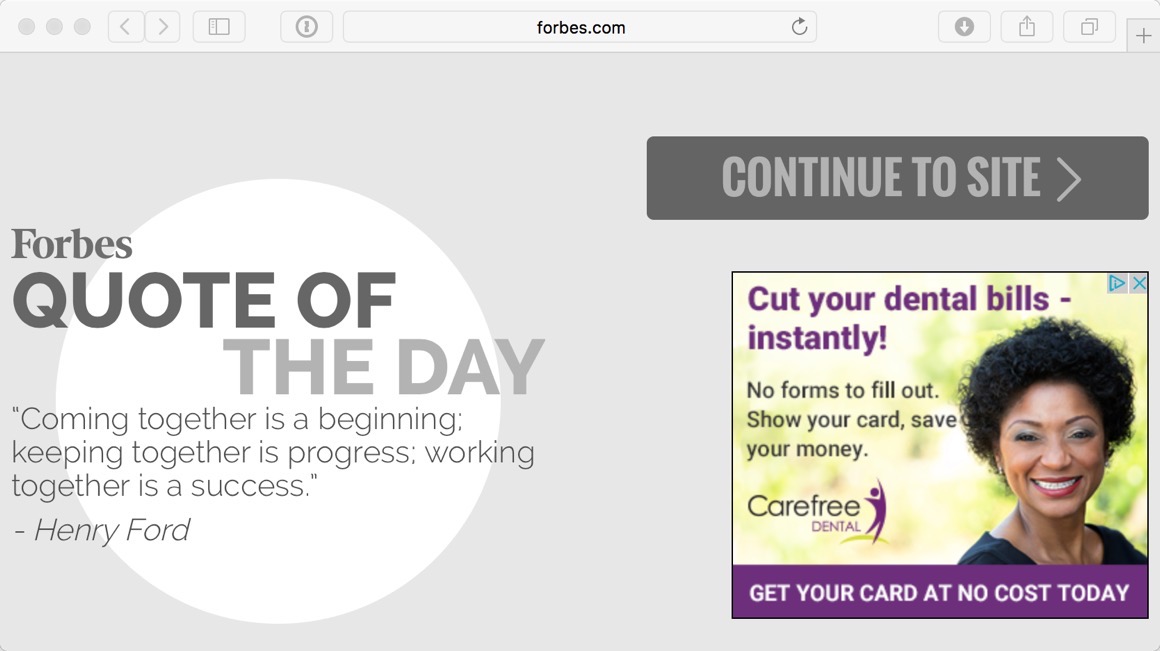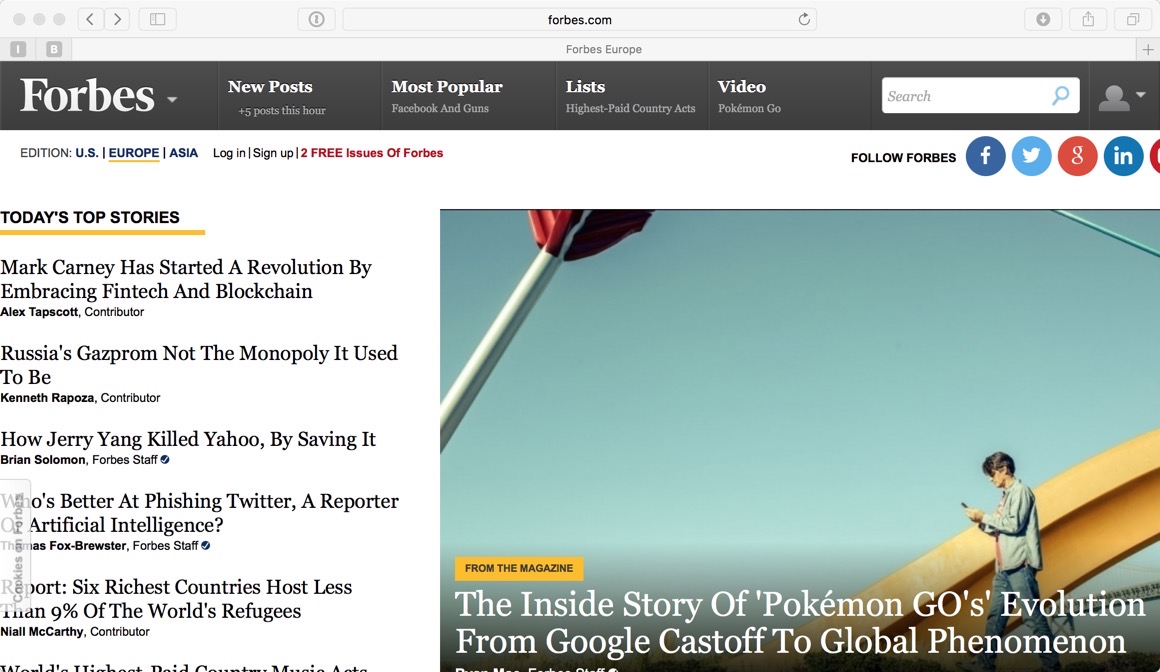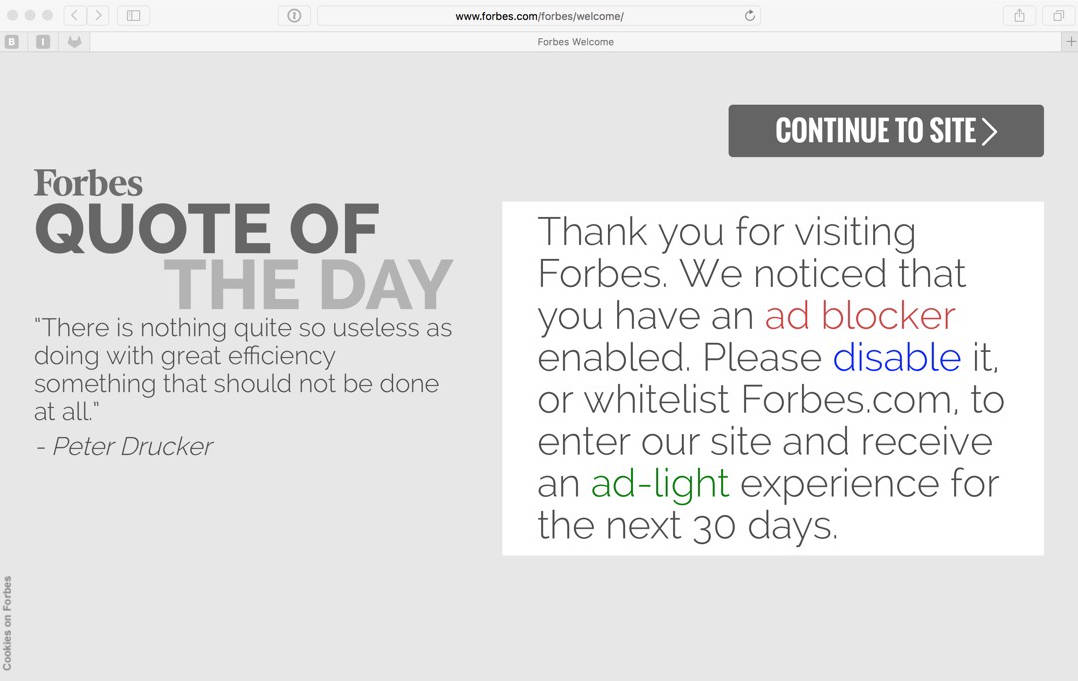Cloud of Shame Forbes (forbes.com)

Every year, one human life worth of time – over 87 years – is lost to one ‘annoying’ doorslam on one site.
When you – a human being – visit Forbes.com, you get a doorslam.
In ad-industry parlance, this is an ‘interstitial’; a modal screen that blocks your progress and displays an advertisement. To rub salt on the wound, Forbes adds a three-second count down to it. Only after the countdown is complete can you click a button to proceed to the actual site.
Let’s be conservative and say that the whole malarkey takes about five seconds to get through if you have lightning fast reflexes. That’s not that bad, is it? And, once you’ve been subjected to it, you don’t see it again until the next day.
Just a second…

What’s 5 seconds × 46,000,000 people?
So what’s the big deal? 5 seconds isn’t a lifetime, is it? Why is Forbes this month’s Cloud of Shame?
Here’s why: by their own admission, Forbes gets 46 million unique visitors to their site every month.
Let’s be conservative again. Let’s say that each one of those visitors visits the site just once a month. Even so, those five seconds quickly add up to over 7 years of human life wasted each month. Because of one interstitial. Just on Forbes.com.
In other words, every year, one human life’s worth of time – over 87 years – is lost to one ‘annoying’ doorslam on one site.
- 46,000,000 people × 5 seconds = 230,000,000 seconds
- 230,000,000 seconds ÷ 60 seconds = 3,833,333 minutes
- 3,833,333 minutes ÷ 60 minutes = 63,888 hours
- 63,888 hours ÷ 24 hours = 2,662 days
- 2,662 days ÷ 365 days = 7.3 years
It‘s time we started taking the externalities of the behavioural advertising industry seriously. One of those externalities is Human Time Wasted. The unit is Lifetimes Lost Per Year.
But don’t worry, because everything you’ve just read only applies to you if you’re a human being. If you’re a robot, you get a much better experience.
VIP lane: robots only

What Google sees: the Googlebot gets shown directly to the content.
If you want to regain your lost 5 seconds, all you have to do is to pretend that you’re a robot. The easiest way to skip Forbes’s doorslam is to set your browser’s user agent to pretend that it’s the Googlebot:
Mozilla/5.0 (compatible; Googlebot/2.1; +http://www.google.com/bot.html)
And, boom!
“Why hello, Mr. Googlebot, right this way, sir… let us take you directly to the content!”
No doorslam, no ad, no pithy quote, no three-second countdown. No sir, that crap’s just for the lowly humans.
“Stop protecting yourselves on the web!”

Forbes’s web site used to ask people to turn off their web malware blockers.
All this is bad, but things were actually even worse before.
Forbes used to detect tracker blockers like Better and block them. You couldn’t get past their doorslam unless you stopped protecting yourself from trackers and malvertising by turning off your blocker. So people did. And what happened? They got served malware.
While Forbes no longer appears to be blocking content blockers, Wired still does. (Note: Better blocks Wired’s blocker blocker).
Is it a coincidence that both Forbes and Wired take a similar approach to tracker blockers? No. The companies behind both publications are members of the Interactive Advertising Bureau (IAB), the trade association for the behavioural advertising industry. Forcing people to turn off their tracker blockers and stop protecting themselves on the web is part of the standard policy called DEAL that the IAB recommends publishers to implement.
Needless to say, we find this practice greatly troubling and we will start treating sites that force people to stop protecting themselves from tracking and malware on the web as malicious sites. You can read more about our Three Strikes And You’re Out policy for how, going forward, we will be dealing with malicious sites by removing them from the Better web experience.
Shame on you, Forbes, for failing to respect human rights, human effort, and human experience. You fail the ethical design test on all counts and that makes you our Cloud of Shame for this month.
Ethical design violations
(Learn more about Ethical Design.)
-
6 trackers
Exposes you to third-party sites.
-
aggressive
Attempts to block malware blockers.
-
doorslam
Interrupts your flow with modal dialogs.
After Better
-
3% Safer
2 requests blocked
-
5% Lighter
106.33 KB saved
-
4% Faster
0.46 seconds saved
| Before | After | Improvement | |
|---|---|---|---|
| Requests: | 78 requests | 76 requests | 3% |
| Weight: | 1.93 MB | 1.83 MB | 5% |
| Speed: | 12.18 seconds | 11.72 seconds | 4% |
Statistics by Better Inspector based on the page as on Saturday, November 10th 2018
About Better
Better is a Safari content blocker for iPhone, iPad, and Mac. It protects you from trackers and malvertising by enforcing the principles of Ethical Design.